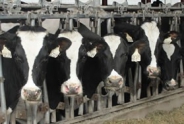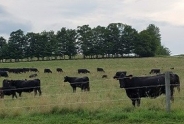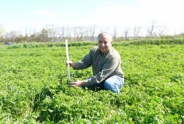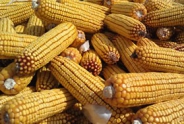Flushing ewes prior to fall breeding season
Ashley McFarland, Area Livestock Specialist
Central New York Dairy and Field Crops
Before we go out and stick our rams in with our ewes we should really consider flushing the ewes we plan to breed this spring. Flushing is predominantly done 2-3 weeks prior to breeding and continued 2-3 weeks into the breeding season. This 4-6 week window allows the ewes to be flushed and get into good shape for being pregnant throughout the summer. Flushing has shown to increase lamp crop and we have seen more twins than singles in most cases. (Twins pay the bills, singles do not!)
This method works best on seasoned (mature) ewes that are body condition scoring (BCS) of 2.5- 3.5. These ewes have gained back weight after nursing lambs this past fall and should be in good condition by April to start flushing for fall lambs. The most success is seen on ewes within the 2.5- 3.5 BCS range. Ewes that are too thin or overly heavy will have a lower response to flushing.
Timing is key to flushing! In this case we are trying to flush ewes to lamb in the fall. It is more beneficial to flush early (April/May) in the season when ovulation rates are naturally high compared to mid-breeding (June/July). Flushing not only will increase the number of ovulations (eggs) in the ewe, but will also improve the survival rate of the lamb in utero. The end goal is there will be more eggs available for fertilization, and the higher chance to survive after birth.
When flushing ewes, studies have shown that feeding corn has been most successful, however there has been some success on pasture. The ewes are requiring an increase in energy and protein in their diet at this time to allow the proper flushing to occur.
The other factor we may run into is breed specifics. Some breeds are known for out of season breeding and some are not. The black face sheep tend to have a much harder time at becoming pregnant during the spring vs late summer/ fall. We can alter this by treating the ewes with progesterone for 10-12 days to synchronize estrus. When the progesterone (CIDR) is removed we then inject gonadotropin (pg 600) into the ewe, the ewe will then exhibit estrus within the next 12-24hrs. At this time we will stick the ram in with these ewes. Ewes do not always catch on first heat even with implanting with progesterone. The most successful lamb crop is produced at the second breeding after applying the CIDR.
It is important to understand that flushing is not ideal for every operation. Not every farm is able to separate ewes off to properly flush the ones they plan on breeding for fall lambs. However if you desire to get the most return on your ewes this would definitely be an option to consider.
Upcoming Events
Labor Roadshow IX
December 1, 2025
December 9 - December 10, 2025December 17 - December 18, 2025December 22, 2025
In-person and online events to keep NY's agricultural employers informed and prepared for today's labor challenges.
Inspired by Annie's: How to Be a Strong Woman Farm Manager
December 10, 2025
December 17, 2025
Free webinars geared towards women who own or operate a farm in NYS.
2026 Dairy Day
January 13, 2026 : Dairy Day - Hamilton
Hamilton, NY
Lunch included
January 14, 2026 : Dairy Day - Ballston Spa
Ballston Spa, NY
Lunch included
Announcements
Statewide Field Crop Pathology Needs Assessment Survey
Your input is wanted for identifying priorities!Sign Up for Our Weekly E-Newsletter
We send out a bi-weekly e-newsletter that has announcements, upcoming programs, and opportunities for you! Registration is quick, easy, and free. Click here to sign up today!Farmers Can Join MeatSuite For Free!
MeatSuite.com is a free resource provided by Cornell University where NY meat farmers can create a farm profile and list their bulk (wholes, halves, quarters) and bundled (i.e. Grilling Bundle) meat products.Why should farmers join?
1. It's free and easy!
2. Connect with more local customers. In the past year the MeatSuite.com farm directory had 8,300 visits from New York consumers. Farm profiles get as many as 25 views per month from potential local customers. We also spotlight MeatSuite farms on social media and bring attention and purchases to farms through highlights and giveaways.
How do I join?
Farmers can visit https://www.meatsuite.com/farmers/ to create a free farm profile. You must list at least one product for your farm's profile to go live. You'll also have access to Cornell's free Meat Price Calculator, a helpful tool for pricing your meat to make a profit.
While you're on MeatSuite, check out the "Creating Consumer-Friendly Bulk Meats" publication on the log-in page. It has tips on how to create bulk meat products that are easier for first-time buyers to say "yes" to.
If you have any questions as you create your farm profile or products, we're here to help! Please email Matt LeRoux at mnl28@cornell.edu.




